|
The Diax range of cameras was made by Walter Voss in Ulm, Germany. The first cameras were high-quality viewfinder cameras called Diax and Diaxette. Soon followed a range of interchangeable lens cameras, the Diax I series with multiple viewfinders for different lenses and the Diax II series with rangefinder and, apart from the first model, an extra viewfinder for telelenses. There was also the rather rare Standard, basically a Diax with interchangeable lens mount. The story of Diax ended with the L-1 with uncoupled lightmeter, which looked somewhat like a non-folding version of the Retina IB v.1 and was presumably Voss's attempt to modernise its line-up. Production stopped at the end of 1957, but Voss left a legacy of high-quality and well-featured cameras that still fetch good prices on the vintage market.
Diax
The first Diax camera saw the light in 1948 and had a miniscule viewfinder, at the rear the eye piece was barely the size of one's pupil! Despite its simple appearance it came with high-quality components like a Compur-Rapid shutter with 1/500s top speed and four-element lenses. In addition, later production had a flash socket next to the shutter.
The leaf shutter was located behind the lens and the camera featured helical focussing, i.e., the whole lens moved during focussing, not just the front cell like on most of Diax's competitors. The aperture control ring was located at the front of the lens. This lens construction was basically the same on the later interchangeable lens models, it seems like the first Diax was already designed with this in mind.
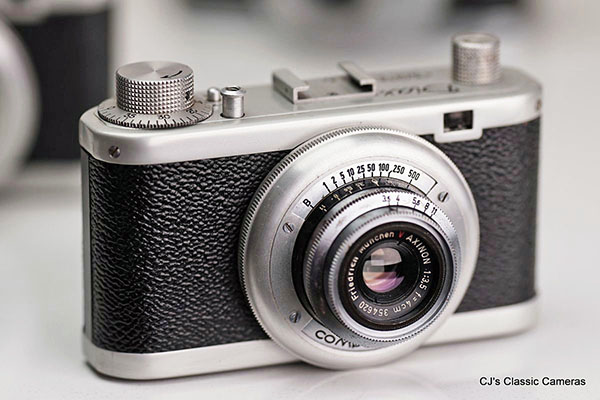
Very first Diax version with Friedrich Axinon 40mm f/3.5 lens. Upon checking this is clearly a four-element Tessar-style lens with a two-element rear group. The body appears to be made from aluminium and had a lacquered coating instead of the chrome of subsequent Diax cameras, giving it a somewhat plastic feel.
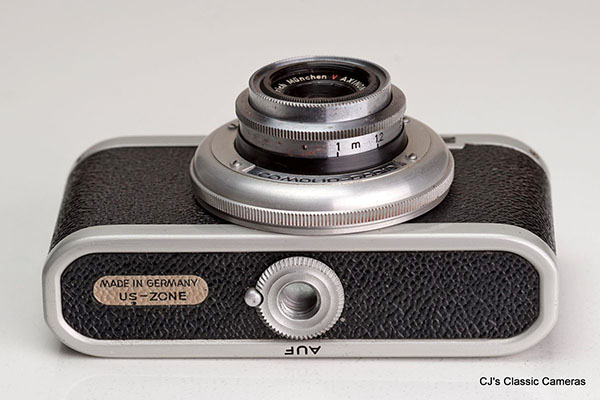
Bottom view of the first Diax. Note the 'Made in Germany US-Zone' sticker, which can occasionally be found on any of the first Diax models.
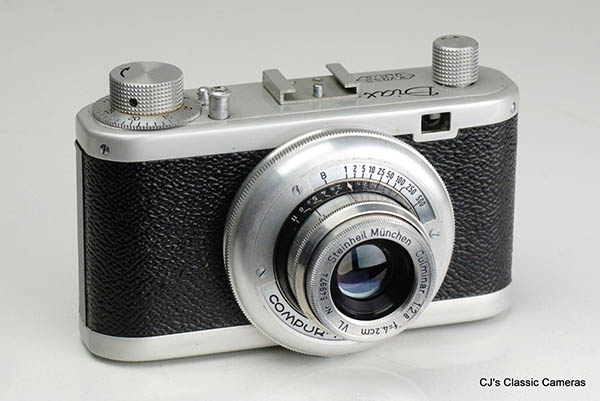
Early Diax version, although not the first, this is a so-called v2. It sported a Steinheil Culminar lens, which I believe is a four-element Tessar-style lens, and had an unusual 42 mm focal length and an f/2.8 aperture. As far as I can tell the v2 was identical to the v1 apart from the lens. The shutter serial# were very close, suggesting the two types were introduced only a few months apart.
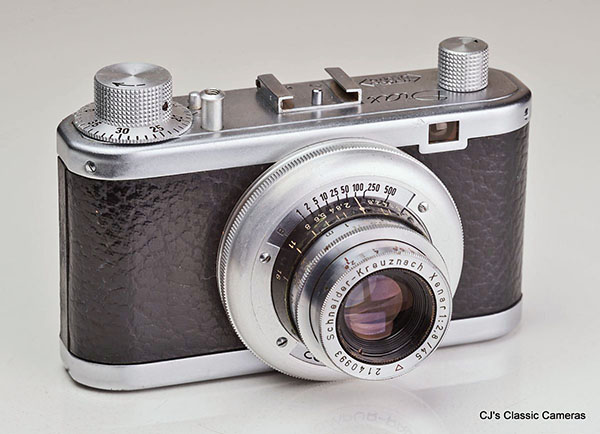
This is a slightly different version to the ones above and below. It has a Xenar lens like the one below, but still lacks the flash shoe. It is also made from a heavier metal (chrome-plated brass I assume), again like the one below, but still has the shutter speed ring from the one above. Clearly, this was a hybrid model. Also note the pattern of the leather, which is quite different than anything I have seen on Diax cameras. Initially I suspected it was a later modification, although if it was, it was a very good job. Then I noticed similar leather on a slightly later Diax elsewhere on the internet. Thus, it looks like original leather, but it was either only used for a very short time or perhaps as an upgrade.
The camera had other advanced features for that time. For instance, the shutter was cocked automatically during winding the film and the camera had a body-mounted shutter release. To load film the whole camera back was removed.
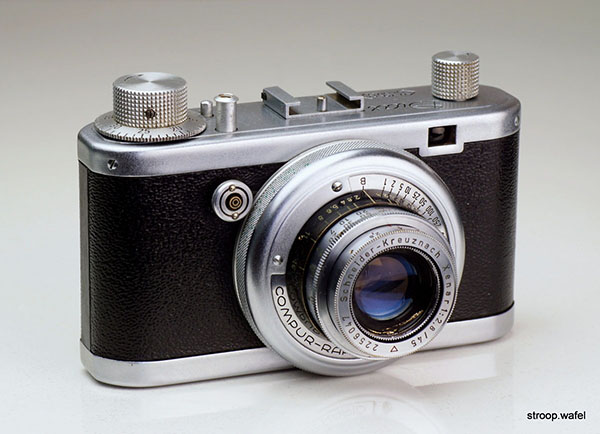
Third and most common version of the first Diax. Although rather similar to the v2, it featured a flash sync socket and a Schneider Xenar 45mm f/2.8 lens. In addition, two studs were added to the bottom plate so the camera would be balnced better whilst standing on a surface. The numbers on the speed ring were rotated 180 degrees compared to the one used on the v2, so they were easier to read when handling the camera.
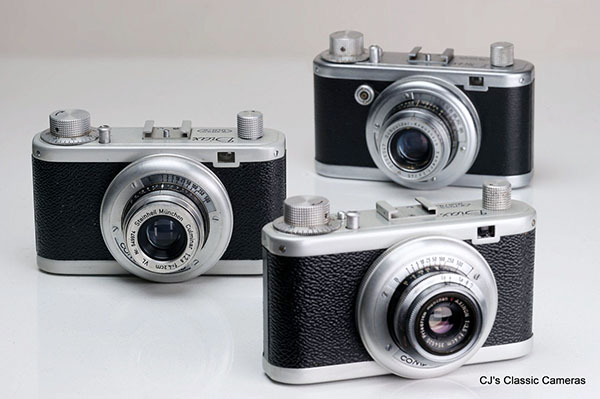
The three different variants of the first Diax shown together.
Diax I
An updated version of the first Diax was introduced around 1950 and was called the Diax I. The 'I' was not marked as such on the camera, but the name Diax I did appear on instruction manuals. The main difference with the preceding model was a slightly larger viewfinder in an elevated section of the top housing. Another small difference was that the elegant little push button securing the locking nut of the camera back on the original Diax was no longer present on the Diax I. Instead, the locking nut had A (for 'Auf'; open) and Z (for 'Zu', closed) marked on it and a double-headed arrow indicating the turning direction. It appears this model was exclusively available with a Schneider Xenar 45mm f/2.8 lens. Later production has Synchro-Compur shutters with a small green self-timer lever beneath the flash sync.
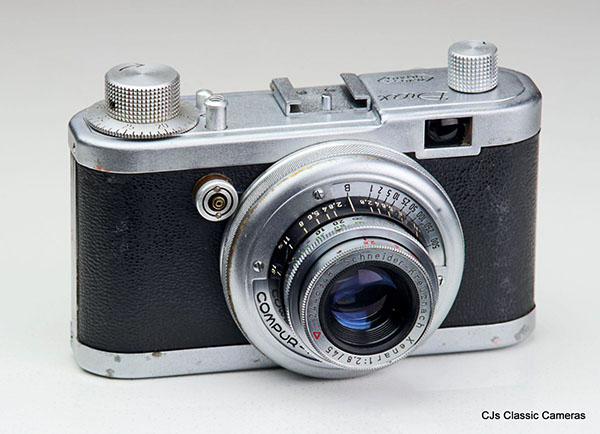
An early Voss Diax I with Compur-Rapid shutter. Only the slightly larger viewfinder and stepped top housing sets this model apart from the original Diax.
Diax II
The Diax II was introduced around early 1952 and featured a rangefinder. The main body construction and functionality was similar to that of the Diax I (see above) but the Diax II had an enlarged top housing to fit the rangefinder. Because of this the rewind knob had to be redesigned, a larger flat version was fitted on top of the housing. It was available with three different lenses, a Schneider f/2.8 Xenar or f/2.0 Xenon, or a Rodenstock f/2.0 Heligon. This is a fairly rare camera, certainly compared to the later Diax Ia,b and IIa,b models.
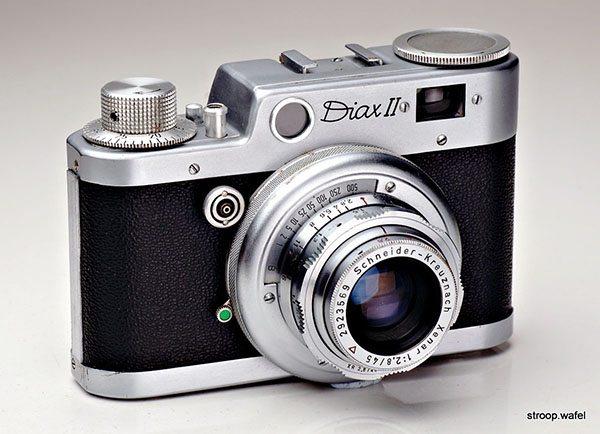
The Diax II, a rangefinder reminiscent of the later Diax IIa but with a fixed lens. It was not dissimilar to the Iloca IIa but better built and with better lens and shutter. Note the knurled focus ring, which was introduced on later production. Early production had the same finely grooved ring as found on the Diax I.
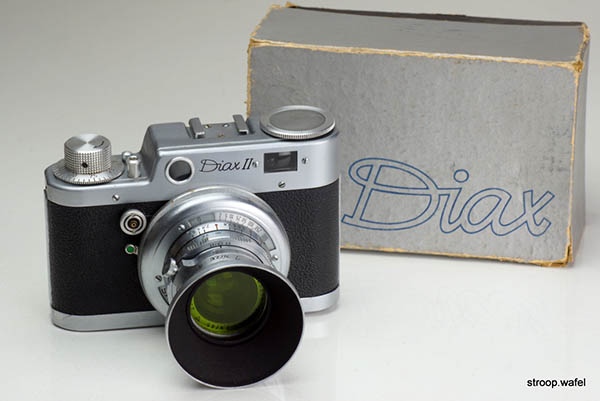
Another look at the Diax II, here with its original box and dedicated lens hood and yellow filter.
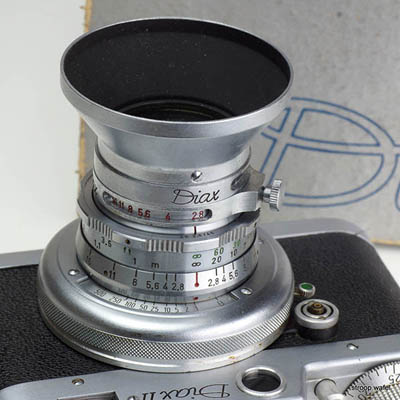
| |
The Diax II came with dedicated lens hood and filters that had gaps in their mounting rings to show the aperture settings on the lens. They could also be stacked.
|
Diaxette
The 1953 Diaxette was a less well-specified version of the Diax I, with a Prontor-S shutter and a three-element Steinheil Cassar lens with front-cell focussing. In contrast to the Diax, the shutter was in-between the lens elements. It was thus very similar to contemporary cameras like the Iloca Ia and the Regula I series, although unlike these cameras the Diaxette automatically cocked the shutter during film winding.
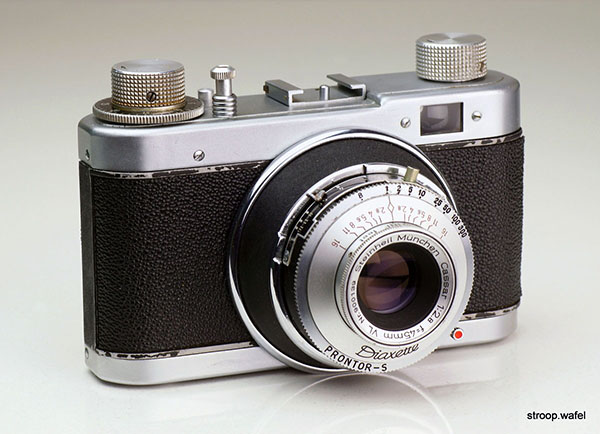
The Diaxette, a less advanced version of the Diax I.
Diax Ia
The 1952 Diax Ia was the first Diax with an interchangeable lens mount. It was a viewfinder camera with no less than three viewfinders for three different focal lengths: 35mm, 50mm and 85-90mm. The viewfinders had different colour filters, the wide angle was blue, the telelens yellow, presumably so one would not confuse the viewfinders when looking through them.
It still had a wind knob, a wind lever was not introduced until the IIa. The camera featured a time delay, although this may not have been immediately obvious: after cocking the Synchro-Compur shutter during film transport, one needed to push the cocking lever a little further along to activate it. The lens mount was a breech mount, the lens was secured by a rotating ring. Several companies adapted their lenses to the Diax mount, including ISCO, Laack and Schneider. Like the first fixed-lens Diax, the aperture was controlled by the front ring, the focus by a ring behind it. Film loading was the same as for the first Diax.
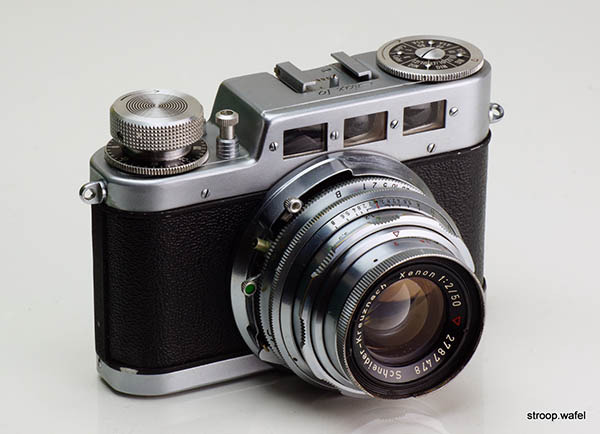
A Diax Ia with Schneider Xenon 50mm f/2, the top lens in the available range of standard lenses. This particular lens has a serial nr. that dates it to late 1951, before the camera was introduced, so must have been one of the first to be made for the Diax mount.
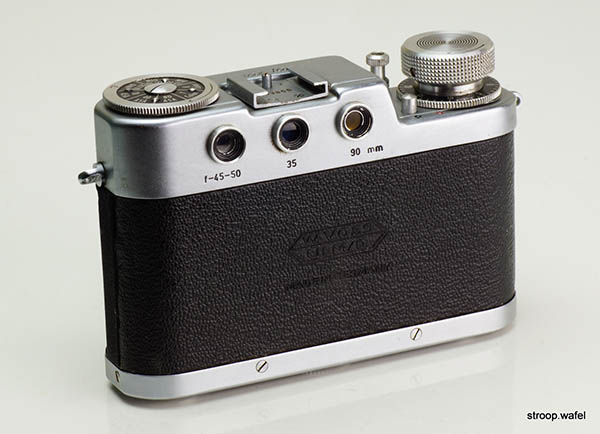
A Diax Ia from behind, showing the three eyepieces for the different focal length viewfinders. The Diax IIa (see below) had only two eyepieces, one for the rangefinder and 50mm lens, and one for the 90mm lens.
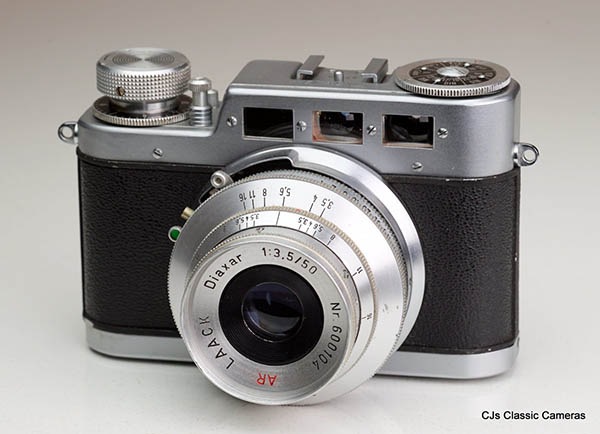
For a short while the Diax Ia was also available with this now very rare Laack AR Diaxar 50mm f/3.5 lens. It was a front-cell focussing lens that lacked rangefinder coupling, like its successor, the Isco Westar as seen on the Diax Standard below. It was a coated triplet lens in a brushed aluminium mount, and thus considerably lighter than the rather hefty Xenar lenses in their solid brass mounts. I have only seen one other example of the Laack Diaxar, which had a serial# about 150 higher than the one seen above. Therefore, most likely no more than a few hundreds were made.
Laack was a not very well-known optical company from Rathenow in Germany, but over the years I have come across several of their lenses, including the Pololyt found on all Altissa Altix I, an Egotar found on a Wirgin Edinex and a Tegonar found on an Altix III.
Diax IIa
The 1954 Diax IIa was developed from the Diax II, which was the first rangefinder Diax. Whereas the Diax II clearly showed its heritage from the Diax I, the Diax IIa had a new interchangeable lens mount and an added viewfinder for a 85-90mm telelens. It looks very much similar to the Diax Ia, it is only at the back that the difference is obvious, as it has only two eyepieces instead of the three the Diax Ia has. The camera featured a coupled coincidence rangefinder.
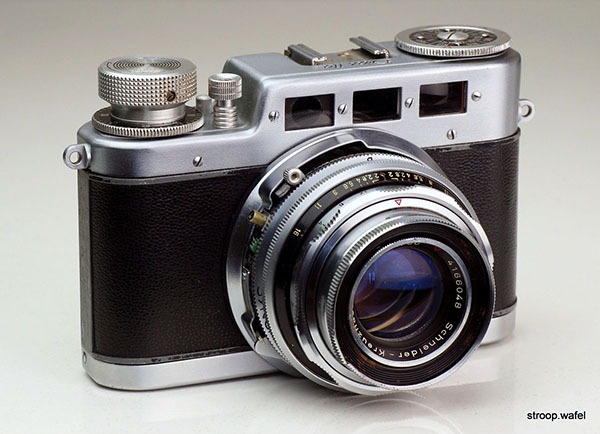
The Diax IIa with, like the Ia, its characteristic set of three windows. From the front there was very little difference with the Ia, only the shutter release button differed slightly. The Schneider Xenon 50mm f/2 is of a different construction than the one on the Diax Ia above, with the two front groups mounted in one brass assembly.
Diax Standard
In the same year as the Diax IIa (1954), the Diax Standard was introduced, but it was only sold in Australia and perhaps New-Zealand. It was essentially a Diax I viewfinder camera (with some improvements) but with an interchangeable lens mount like on the Diax Ia/IIa. As it was a viewfinder camera, there was no need for rangefinder coupling, and in fact the standard lens it came with, an Isco-Gottingen Westar, was a front-cell focussing lens without a rangefinder cam. To use lenses with other focal lengths one would need an additional viewfinder, but then one would have been better off with a Diax Ia, so the point of this model escapes me a little, unless one considers it as a relatively cheap entry model into the Diax range. The camera must have sold in relatively small numbers only, as, if the information on the internet is true, very few were made (ca. 200 in total) and only very little are known to survive today, certainly outside Australia.
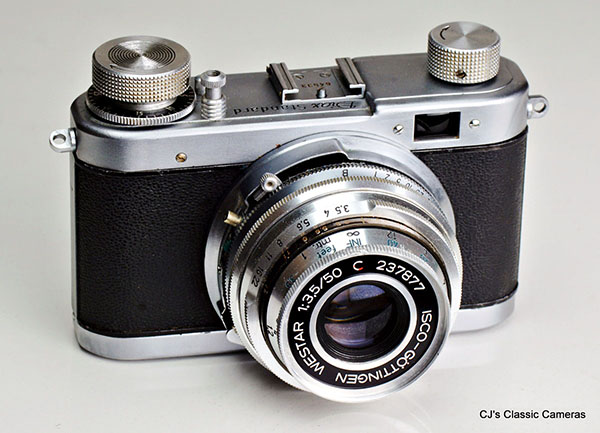
A lucky find was this Diax Standard with Isco-Gottingen Westar 50mm f/3.5 lens in Synchro-Compur shutter. Not the most advanced Diax model, but certainly the rarest.
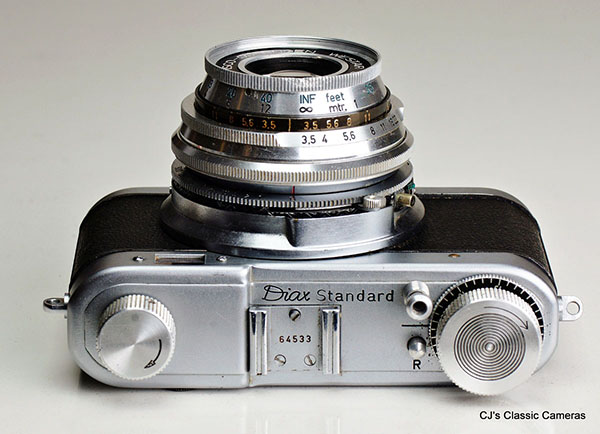
Top view of the Diax Standard. It was very much based on the Diax I but with the upgraded wind knob and release button of the Diax Ia/IIa, in addition of course to the interchangeable lens mount.
Diax Ib
Like the Diax Ia, the 1956 Diax Ib was a viewfinder camera with viewfinders for three focal lengths. However, it had a flat streamlined tophousing camera and wind lever film advance.
The interchangeable lenses were marked Diax or Diax b. The Diax b lenses are mounted rotated 90 degrees CW compared to Diax lenses (without b). Thus, when mounting a Diax b lens on a Diax Ia or IIa camera, the focus scale will not be on top but on the right hand side. The rangefinder coupling still works, so it is hardly a problem, but I am clueless as to why Voss changed the configuration of the mount.
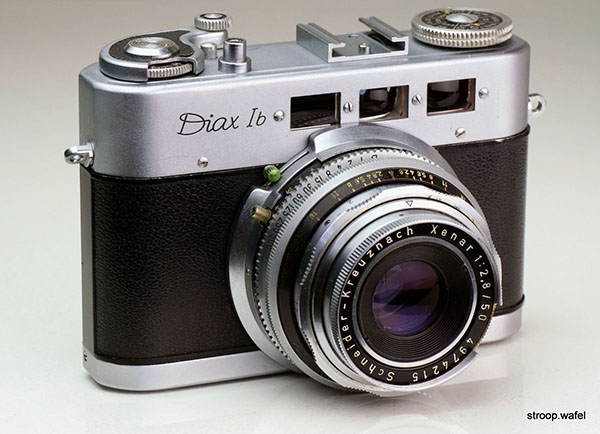
A Diax Ib with new streamlined top housing and wind lever.
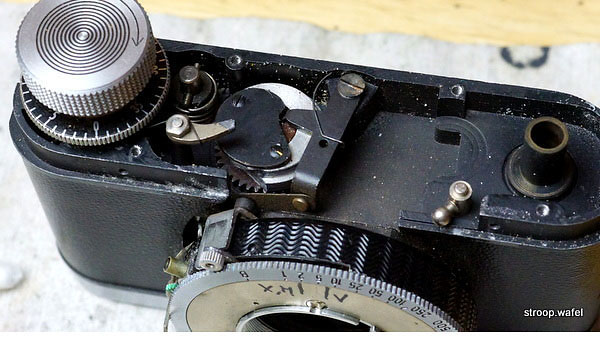
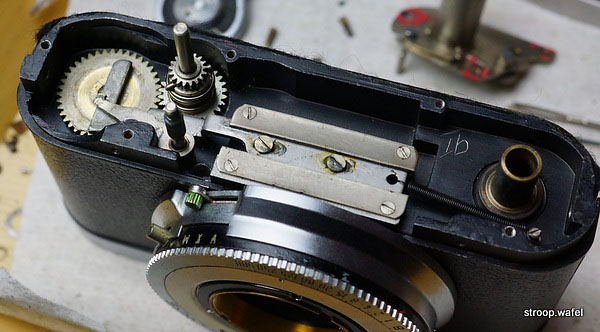
The difference between Diax I/II a and b versions did not just involve a change from wind knob to wind lever, but also the shutter cocking mechanism changed. On top is the Diax IIa, here a rotating as
symetrical wheel pushes a lever which cocks the shutter. On the bottom is the Diax Ib, which has a piston-like mechanism. Also note that the rotation is opposite: the wind lever turns counter-clockwise, the wind knob turns clockwise.
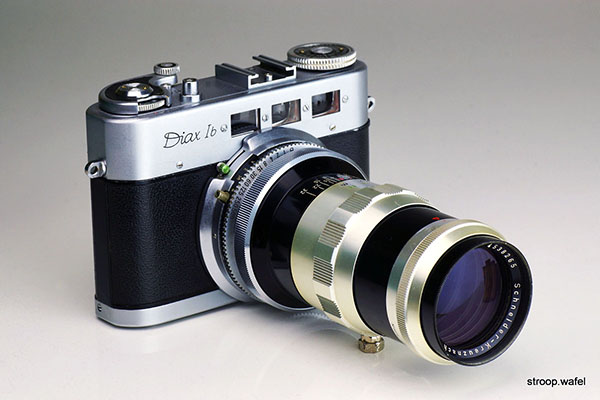
A Diax Ib with 135mm telelens, the longest (size as well as focal length!) lens available for the Diax system. One would need a separate viewfinder for it such as the one shown below on the Diax IIb, as the body itself only has one for the 90mm telelens. The lacquer used to finish the metal has gone rather yellow over time.
Diax IIb
The 1956 Diax IIb was developed from the Diax IIa, with similar new features as the Diax Ib had: a flat streamlined tophousing and wind lever to advance the film and cock the shutter. As one of the windows is the rangefinder window, the Diax IIb misses the 35mm viewfinder present on the Diax Ib.
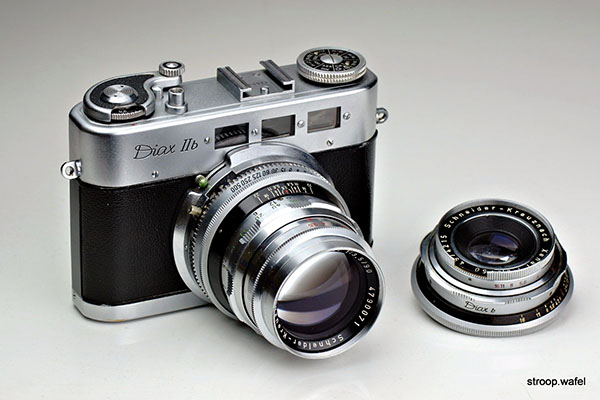
A Diax IIb with Schneider Tele-Xenar 90mm f/3.5 lens mounted. The Diax IIb had a build-in viewfinder for this lens. Also pictured is a Schneider Xenar 50mm f/2.8 lens. Note the 'Diax b' marking, indicating the lens was meant for the Diax Ib/IIb series, although they could be used on the Diax Ia/IIa without any problem.
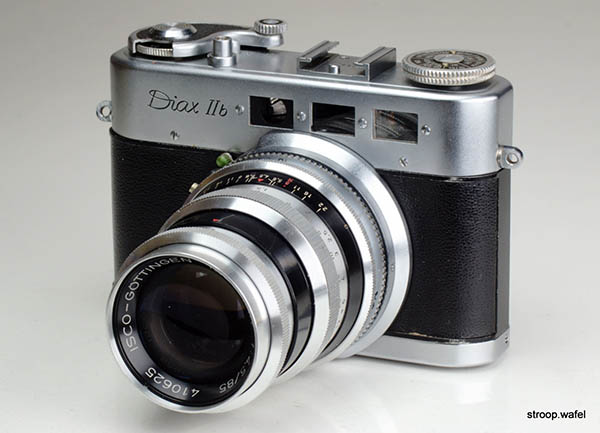
An alternative choice for short telelens was the Isco Isconar 85mm f/4.5 lens shown here, slightly slower than the Tele-Xenar but otherwise an excellent lens.
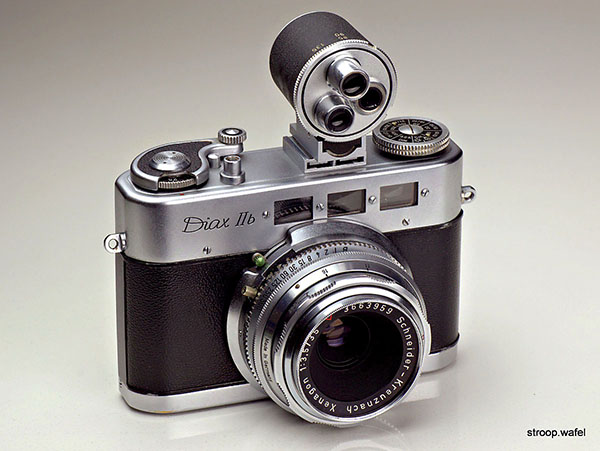
Diax also sold a turret viewfinder for 35mm, 90mm and 135mm lenses, made by Steinheil. The Diax Ia and Ib had 35mm viewfinders but the Diax IIa and IIb did not, so an accessory viewfinder was neccessary to use these models with the wide-angle Schneider Xenagon 35mm f/3.5 lens pictured.
Diax-L-1
The Diax L-1 was introduced in 1957 and represented the first, and unfortunately last, model of a completely redesigned Diax camera range. Whether it was a change for the better can be debated. Little was left of the characteristic original Diax look, instead the company chose produce a fixed lens viewfinder camera that fitted in with other contemporary camera designs like the Kodak Retinette and Agfa Silette. On the positive side, this was the first Diax with lightmeter and it was not a bad camera, but it did little to stand out from the competition. It did have one new nifty feature, however: a frame counter that automatically reset to zero when the camera back was opened. If that made up for the somewhat akward positioning of the frame counter window at the front of the camera beneath the rewind knob, I'm not sure. Considering its rarity nowadays, it probably was not very succesful. The Diax factory stopped production late 1957.
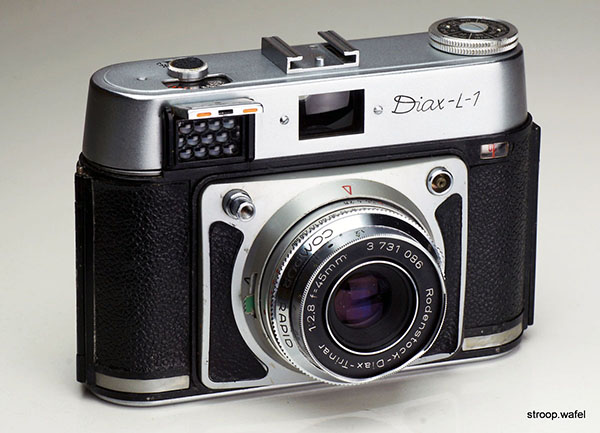
A Diax L-1 with Rodenstock-Diax-Trinar 45mm f/2.8 lens in Compur-Rapid shutter.
| 
